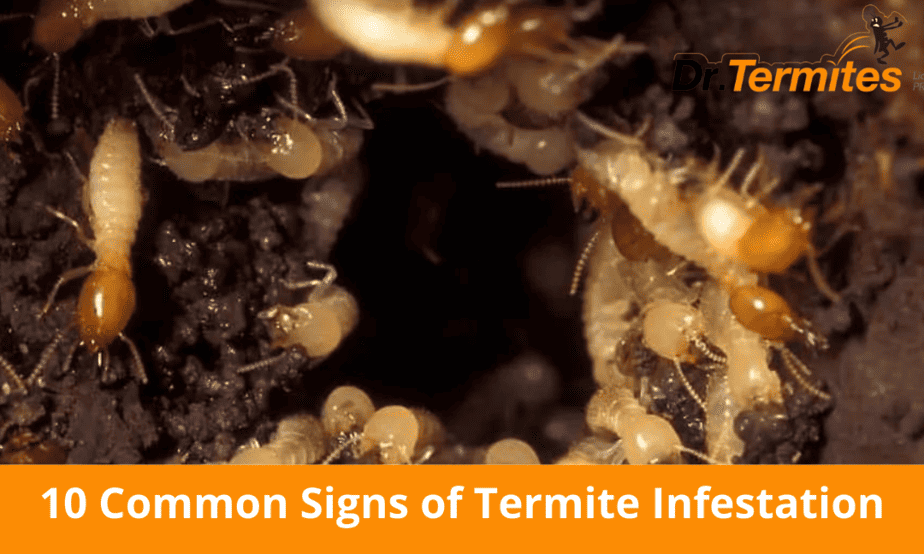In keeping your home well-maintained and safe enough for your loved ones, there are many things to watch out for. Apart from molds, leaks, broken fixtures, and the like, one of the most crucial things to identify are signs of termite infestation.
Once a colony of termites has penetrated your home, it can be very difficult to completely wipe them out of your property. You will have to ensure that every single one of them has been eradicated, because if there is even a single reproductive survivor despite your pest control efforts, that lone reproductive termite can start a whole new colony again.

Moreover, there can be more than one infestation site in a given property. For these reasons, it is very important to look out for the top 10 common signs of termite infestation and call a professional pest control company once you identify any of them.
In no particular order, here are the indications to keep an eye out for:
Sign #1: Hollowed-out Wood
Termites feast on wood from the inside out. For this reason, an infestation can be hard to spot – not until you notice your wooden walls, floors, and furniture getting hollow. They chew through the wooden objects and leave behind long grooves that somewhat look like a maze or honeycomb patterns. Because all that’s left when they are finished are the grooves with holes in between, this can easily weaken the wood and cause it to collapse.
It may not be obvious just by looking at them, but you can tell by gently tapping on your wooden areas and listening if they sound empty.
Sign #2: Mud Tubes
Subterranean termites are known to nest underground as they require soil to survive and only come to the surface when hunting for food. They feast on both wet and dry wood and usually target your home starting from the ground up.
You can find their trail in the form of mud tubes in the foundation of your home or even on trees. Because they love warmer climates, these mud tubes also shield them from the cold or dry air. The more mud tubes they formulate, the more your property turns into a welcoming environment they can thrive.
Sign #3: Bubbling Paint
The main component of wood that termites target is cellulose, which is also present in drywall. If you notice bubbling paint, wallpaper, or even pin-sized holes within your drywall, this can be a sign of termites chewing their way through.
Sign #4: Structural Damage
We’ve mentioned earlier to look out for hollowed wood, this is also to prevent further structural damage to your home. It’s not only in the walls, floors, or wooden furniture but also in ceilings, support beams, and your property’s foundation.
When termites eat through these, it can significantly compromise the integrity and durability of your home. Not only is this very dangerous but it can also be very difficult and expensive to remedy.
Sign #5: Swarmers
Swarmers are also known as flying termites (yes, it’s terrible, they can fly, too). The main reason termites fly off is to find mates elsewhere and start new colonies on their own. You can expect to see thousands of termites with every storm, with this occurrence happening mostly in spring.
If you notice a swarm of flying termites near your property, this is a sign that there are infestations nearby.
Sign #6: Discarded Termite Wings
Termites that are inside your own can be very attracted to natural light coming from outside. Because of this, they will fly towards it and twist their wings off once they are near. You may find these discarded wings by windows, doors, and other entry points. This indicates active termites looking to build new colonies nearby.
Sign #7: Drywood Termite Droppings
As their name suggests, drywood termites love to eat and nest inside dried-out wood. Because wood comprises their entire diet, their droppings will also be made of wood. To keep their surroundings clean, they kick out all excrement from their nest, which looks like tiny pellets almost similar to sawdust. Seeing this indicates drywood termites right below the surface.
Sign #8: Moldy Scent
Many types of termites love moist wood, which usually has a moldy scent. If you notice a similar smell, this could be a sign of infestations nearby or at the very least, something that could attract an infestation.
Sign #9: Stuck Doors or Windows
Because termites eat through wood, they can cause the structure to buckle, warp, or break apart. Because of this, it can make opening and closing doors and windows a little tricky. If not tricky, you may notice that they can no longer close all the way.
Sign #10: Uneven Flooring or Tiles
Termites that target your flooring can cause uneven foundations or loosen out your tiles. You may even notice noisier wooden floors when you walk over them.
Conclusion
Look out for these 10 common signs of termite infestations to prevent outbreaks from spreading and keep your home termite-free! For quick and effective termite control solutions, call Dr. Termites and we’ll send over a team of experts today!































